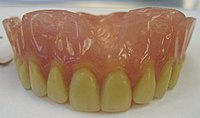
Photo from wikipedia
Introduction The adhesives used to bond orthodontic retentions are low‐loaded composite resins with a resinous matrix containing bisphenol A diglycidyl ether dimethacrylate synthesized from bisphenol A (BPA), fluidizers such as… Click to show full abstract
Introduction The adhesives used to bond orthodontic retentions are low‐loaded composite resins with a resinous matrix containing bisphenol A diglycidyl ether dimethacrylate synthesized from bisphenol A (BPA), fluidizers such as triethylene glycol dimethacrylate (TEGDMA) and hydrophilic polymers such as hydroxyethylmethacrylate. BPA disrupts the endocrine balance, and TEGDMA has high risks for human health: eg, allergies and cytotoxicity. The aim of this study was to evaluate in vitro the release of monomers from orthodontic bonded retentions. Methods A reproducible model of bonded retentions was carried out using calibrated molds. We analyzed the release of monomers by gas phase chromatography coupled with mass spectrometry. Results This model allowed us to qualitatively and quantitatively evaluate the in‐vitro release of monomers from orthodontic adhesives. The quantitative and qualitative analyses showed no BPA release above the 0.02 ppm detection limit. A greater release of TEGDMA was observed with Transbond LR (31.7 &mgr;g/mL) than with Transbond XT (13.12 &mgr;g/mL) (both, 3M Unitek, Monrovia, Calif). Other toxic components (iodobenzene, iodobiphenyl, triphenyl stibine, and so on) were also identified. Conclusions Toxic and carcinogenic molecules not mentioned in the material safety data sheets were identified. HighlightsFixed retainers are frequently bonded with Bis‐GMA resins synthesized from BPA.Gas phase chromatography‐mass spectrometry measures monomers (types, quantities).No BPA was found at the detection level of 0.02 ppm.Transbond XT and Transbond LR adhesives do not exhibit the same release kinetics.Other toxic components (iodobenzene, triphenyl stibine) have been identified.
Journal Title: American Journal of Orthodontics and Dentofacial Orthopedics
Year Published: 2018
Link to full text (if available)
Share on Social Media: Sign Up to like & get
recommendations!